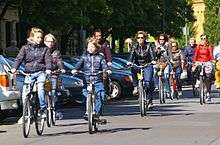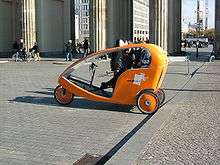Cycling in Berlin

Cycling in Berlin is a significant form of transport in the German capital where around 500,000 daily bike riders accounted for 18% of total traffic in 2013.[1] The city has highly developed bicycling infrastructure[2] and it is estimated that Berlin has 710 bicycles per 1000 residents.
Bicycle network

Berliners have access to 620 km (390 mi) of bike paths including around 150 km (93 mi) mandatory bicycle paths, 190 km (120 mi) off-road bicycle routes, 60 km (37 mi) of bike lanes on the roads, 70 km (43 mi) of shared bus lanes open to cyclists, 100 km (62 mi) of combined pedestrian/bike paths and 50 km (31 mi) of marked bike lanes on the sidewalks.[3]
In addition to a variety of bike paths and bike lanes there are also Fahrradstrassen (bicycle streets) where bikes have priority and vehicles are limited to 30kmh.
Along the former path of the Berlin Wall there is now the Berliner Mauerweg, the Berlin Wall Trail. It is a circular route, completed in 2006, and traces the former German Democratic Republic border fortifications that surrounded West Berlin.[4]
Long-distance routes
There are a number of regional and long-distance bike paths that run through Berlin. These include the Berlin-Copenhagen trail, Berlin-Usedom Cycle Route and the European Cycle Route R1.
Bicycles on public transport
Riders are allowed to carry their bicycles on Berlin's S-Bahn and U-Bahn trains, on trams, and on night buses[5] if a bike ticket is purchased.[6]
Bicycle hire system

Berlin's bicycle hire system, Call a Bike, is run by the Deutsche Bahn.
BikeSurfBerlin is a bicycle sharing project, where you can borrow bikes for free, or on donation basis.[7]
Velotaxi
In the 1997, Berlin-made cycle rickshaws called velotaxis were created.[8] The tickets are about 1/2 the cost of regular taxis. Velotaxis are three-wheeled vehicles with a "space-age lightweight plastic cab that is open on both sides", a space for a driver, and behind the driver, space for two passengers.[9] They have been invented by Ludger Matuszewski, the founder of "Velotaxi GmbH" company.
Velodrom
The Velodrom (Berlin) is an indoor track cycling arena. Holding up to 12,000 people, it was also Berlin's largest concert venue, until the opening of O2 World in 2008.
It is part of a larger complex, which includes a swimming pool as well, built in the course of the application of Berlin, for the 2000 Summer Olympics.
See also
References
- ↑ "Platz da! – für die Radfahrer". ND. Retrieved 22 March 2011.
- ↑ "Bike City Berlin". Treehugger. Retrieved 19 August 2008.
- ↑ "Bicycle Routes and Facilities Bicycle Paths". Senate Department of urban development. Archived from the original on 22 September 2008. Retrieved 19 September 2008.
- ↑ "A Berlin ride like no other". BBC. Retrieved 4 November 2016.
- ↑ "Mit dem Fahrrad - In Bussen und Bahnen" [By Bicycle - In Buses and Trains] (in German). Senate Department of Urban Development. Retrieved 2010-06-15.
- ↑ S-Bahn Tickets
- ↑ BikeSurfBerlin
- ↑ "Cabs for the Carfree City". Christine Lepesto. Retrieved 4 November 2016.
- ↑ Boye De Mente (2010). Demetra De Ment, ed. The Bizarre and the Wondrous from the Land of the Rising Sun!. Cultural-Insight Books. pp. 95–96. ISBN 1456424750.
External links
- Bicycle Routes and Facilities, (Senate of Berlin)
- Bikes Berlin, English-language community cycling forum